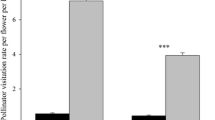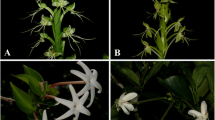Summary
In the eastern Andes of Colombia, the shrub Befaria resinosa (Ericaceae) has peaks of flowering that are separated by extended periods of low flower production. The effect that these fluctuations in flower production have on pollen flow was investigated by using fluorescent dye as a pollen analog. Dye applied to open flowers was dispersed over long distances more often during low flower production than during high flower production. Whether enhanced pollen dispersal during flowering lows is of benefit to individual plants is not clear. The proportion of flowers that set fruit is positively correlated with flower abundance, negating the possibility that increased pollen dispersal results in a higher rate of fruit production due to outbreeding effects. It is also difficult to attribute the pattern of fruit production to changes in pollinator visitation rates, which are negatively correlated with flower abundance in the case of hummingbirds and not correlated at all with flower abundance in the case of insects. An opportunistic, large-bodied hummingbird (Colibri coruscans) visits B. resinosa during high flowering and may be a particularly effective pollinator, accounting for some of the increase in the proportion of flowers setting fruit. Rainfall is positively correlated with flower production and may be an important factor in shaping flowering phenology, but it is not significantly correlated with the proportion of flowers setting fruits. The possibility that low-level flowering may counteract inbreeding that results from peak flowering is discussed.
Similar content being viewed by others
References
Augspurger CK (1980) Mass-flowering of a tropical shrub (Hybanthus prunifolius): influence on pollinator attraction and movement. Evolution (Lawrence, Kans) 34:475–488
Augspurger CK (1981) Reproductive synchrony of tropical plants: experimental effects of pollinators and seed predators on Hybanthus prunifolius (Violaceae). Ecology 62:775–788
Augspurger CK (1983) Phenology, flowering synchrony, and fruit set of six neotropical shrubs. Biotropica 15:257–267
Bawa KS (1983) Patterns of flowering in tropical plants. In: Jones CE, Little RJ (eds) Handbook of experimental pollination biology. Van Nostrand Reinhold Company Inc., New York pp 394–410
Beattie AJ (1971) A technique for the study of insect borne pollen. The Pan-Pac Entomol 47:82
Bertin RI (1982) Floral biology, hummingbird pollination and fruit production of trumpet creeper (Campsis radicans, Bignoniaceae). Am J Bot 69:122–134
Camargo LA (1979) Catalogo ilustrado de las plantas de Cundinamarca, Vol. VII: Clethraceae, Pyrolaceae, Ericaceae. Instituto de Ciencias Naturales, Universidad Nacional, Bogota, Colombia
Carpenter FL (1976) Plant-pollinator interactions in Hawaii: pollination energetics of Metrosideros collina (Myrtaceae). Ecology 57:1125–1144
Croat TB (1975) Phenological behavior of habit and habitat classes on Barro Colorado Island (Panama Canal Zone). Biotropica 7:270–277
Ellstrand NC, Torres AM, Levin DA (1978) Density and the rate of apparent outcrossing in Helianthus annuus (Asteraceae). Syst Bot 3:403–407
Farris MA, Milton JB (1984) Outcrossing rate and heterozygote superiority in Ponderosa Pine. Evolution 38:1151–1154
Feinsinger P (1978) Ecological interactions between plants and hummingbirds in a successional tropical community. Ecol Monogr 48:269–287
Frankie GW, Baker HG, Opler PA (1974) Comparative phenological studies in tropical wet and dry forests in the lowlands of Costa Rica. J Ecol 62:881–920
Frankie GW, Opler PA, Bawa KS (1976) Foraging behavior of solitary bees: implications for outcrossing of a neotropical forest tree species. J Ecol 64:1049–1057
Gentry AW (1974) Flowering phenology and diversity in tropical Bignoniaceae. Biotropica 6:64–68
Handel SN (1983) Pollination ecology, plant population structure, and gene flow. In: Real L (ed) Pollination biology, Academic Press, New York, pp 163–211
Janzen DH (1967) Synchronization of sexual reproduction of trees within the dry season in Central America. Evolution (Lawrence, Kans) 21:620–637
Janzen DH (1971) Seed predation by animals. Annu Rev Ecol Syst 2:465–492
Kodric-Brown A, Brown JH, Byers GS, Gori DF (1984) Organization of a tropical island community of hummingbirds and flowers. Ecology 65:1358–1368
Levin DA (1979) Pollinator foraging behavior: genetic implications for plants. In: Solbrig OT, Jain S, Johnson GB, Raven PH (eds) Topics in plant population biology. Columbia University Press, New York, pp 131–153
Levin DA, Kerster HW (1974) Gene flow in seed plants. Evol Biol 7:139–220
Linhart YB (1973) Ecological and behavioral determinants of pollen dispersal in hummingbird-pollinated Heliconia. Am Nat 107:511–523
Linhart YB, Feinsinger P (1980) Plant-hummingbird interactions: effects of island size and degree of specialization on pollination. J Ecol 68:745–760
Nevling LI (1971) The ecology of an elfin forest in Puerto Rico, 16: The flowering cycle and an interpretation of its seasonality. J Arnold Arbor 52:286–613
Opler PA, Frankie GW, Baker HG (1980) Comparative phenological studies of treelet and shrub species in tropical wet and dry forests in the lowlands of Costa Rica. J Ecol 68:167–188
Price MV, Waser NM (1982) Experimental studies of pollen carryover: hummingbirds and Ipomopsis aggregata. Oecologia (Berlin) 54:353–358
Primack RB, Silander JA (1975) Measuring the relative importance of different pollinators to plants. Nature (London) 255:143–144
Rathcke B, Lacey EP (1985) Phenological patterns of terrestrial plants. Annu Rev Ecol Syst 16:179–214
Schaffer WM, Schaffer MV (1979) The adaptive significance of variations in reproductive habit in the Agavaceae. II. Pollinator foraging behavior and selection for increased reproductive expenditure. Ecology 60:1051–1069
Schauensee RM de, Phelps Jr WH (1978) A guide to the birds of Venezuela. Princeton University Press, Princeton, New Jersey
Schemske DW (1980) Floral ecology and hummingbird pollination of Combretum farinosum in Costa Rica. Biotropica 12:169–181
Schemske DW (1983) Limits to specialization and coevolution in plant-animal mutualisms. In: Nitecki MH (ed) Proceedings of the Fifth Annual Spring Systematics Symposium: Coevolution. The University of Chicago Press, Chicago, pp 67–109
Schmitt J (1983) Density-dependent pollinator foraging, flowering phenology, and temporal pollen dispersal patterns in Linanthus bicolor. Evolution (Lawrence, Kans) 37:1247–1257
Silander JA Jr (1978) Density-dependent control of reproductive success in Cassia biflora. Biotropica 10:292–296
Stephenson AG (1982) When does outcrossing occur in a mass-flowering plant? Evolution (Lawrence, Kans) 36:762–767
Thomson JD (1981) Spatial and temporal components of resource assessment by flower-feeding insects. J Anim Ecol 50:49–59
Waddington KD (1980) Flight pattern of foraging bees relative to density of artificial flowers. Oecologia (Berlin) 44:199–204
Waser NM (1979) Pollinator availability as a determinant of flowering time in Ocotillo (Fouquieria splendens). Oecologia (Berlin) 39:107–121
Willson MF, Bertin RI (1982) Flower-visitors, nectar production, and inflorescence size of Asclepias syriaca. Can J Bot 57:1380–1388
Author information
Authors and Affiliations
Rights and permissions
About this article
Cite this article
Melampy, M.N. Flowering phenology, pollen flow and fruit production in the andean shrub Befaria resinosa . Oecologia 73, 293–300 (1987). https://doi.org/10.1007/BF00377521
Received:
Issue Date:
DOI: https://doi.org/10.1007/BF00377521




